#vertebral column
Explore tagged Tumblr posts
Text
Cervicobrachial neuralgia: pain that radiates from the neck to the arm
What is cervicobrachial neuralgia?
Cervicobrachial neuralgia is a painful condition that manifests itself as pain radiating from the neck down the arm, sometimes as far as the fingers. The pain is caused by compression or irritation of a nerve root in the neck.

What are the causes?
The most common causes of cervicobrachial neuralgia are :
- Herniated cervical disc: A piece of intervertebral disc slips out of place and compresses a nerve root.
- Cervical osteoarthritis: Wear and tear on the cervical joints can lead to nerve compression.
- Spinal canal stenosis: A narrowing of the canal containing the spinal cord and nerves.
- Facet joint disease: Inflammation of the small joints between the vertebrae.
What are the symptoms?
The symptoms of cervicobrachial neuralgia may vary depending on the nerve root affected, but they generally include :
- Pain: Sharp, stabbing pain that starts in the neck and radiates down the arm, forearm and fingers.
- Numbness: In the area innervated by the compressed nerve.
- Tingling: Tingling sensation.
- Muscle weakness: In the upper limb.
How is cervicobrachial neuralgia diagnosed?
The diagnosis is made by a doctor specialising in diseases of the spinal column (neurologist, rheumatologist, orthopaedist) on the basis of :
- Clinical examination: The doctor will look for painful points, assess neck mobility and reflexes.
- Complementary examinations:
o X-ray: To visualise the bones and joints.
o CT scan: To obtain more detailed images of the spine.
o MRI: To view the intervertebral discs, nerves and soft tissues.
What are the treatments?
Treatment for cervicobrachial neuralgia depends on the cause and severity of symptoms. It may include :
- Medication: Anti-inflammatories, analgesics, muscle relaxants.
- Physiotherapy: To strengthen neck muscles and improve mobility.
- Infiltrations: Corticosteroid injections to reduce inflammation.
- Physical treatment: Heat, cold, ultrasound.
- Surgery: In the most serious cases, surgery may be required to decompress the nerve root.
How can cervicobrachial neuralgia be prevented?
It is not always possible to prevent cervicobrachial neuralgia, but certain measures can help reduce the risk:
- Maintain good posture: Avoid staying in the same position for too long.
- Regular exercise: Strengthens back muscles and improves posture.
- Lifting correctly: To avoid putting excessive strain on the spine. In conclusion, cervicobrachial neuralgia is a painful condition that can be disabling. Early diagnosis and appropriate treatment are essential to relieve symptoms and improve patients' quality of life.
Go further
0 notes
Text
One of the best details of Buddy Daddies is to see how Rei's posture improved when he stopped being a murderer.
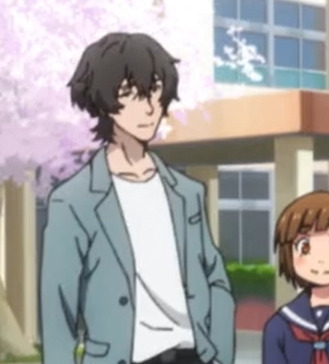

It is even preserved upright years later, being a dilf.
It is no longer a robot in off mode, and on when it is a killer. Now it's papa Rei cooking toast! 🥪
#I love papa Rei#His vertebral column will thank you!#Buddy Daddies#rei papa#Kazuki papa#Miri chan#miri unasaka#buddy daddy spoilers
2K notes
·
View notes
Text

ok maybe I have gotten better at outfit design bc younger me would've never thought to make Aadrios' cape completely bat-like, AND to put a vertebral column on the back of his jacket.
Though... I MAY change his hairstyle a bit to make the back easier to see? Decision pending. I love the long straight hair but I've always kinda felt like the backside of his design was a bit hard to read with all the long stuff in it (his early designs had a long cape instead of this short batty one). Maybe a braid that falls down the front instead? Maybe.
#like the vertebral column... is sexy as hell. 'necromancy at its finest' as aadrios has said at least once#ocs#character: aadrios#call of the overseer
6 notes
·
View notes
Text
its me and my 10 page list of anatomical terms i need to know and be able to identify on a cadaver against the world
#AAAAAAAA#AAAAAAAAAAAAAAA#AAAAAAAAAAAAAAAAAAAAAAAAA#AAAAAAAAA#AAAAAAAAAAAAAAAAAAAAA#AAAAAAAAAAAAAAAAAAAAAAAAAAAAAAAAAAAAAAAAA#anyway#what do yall know about the longissimus#it originates at the thoracic and lumbar transverse processes and inserts at cervical and thoracic transverse processes and mastoid process#bilaterally is extends the vertebral column and head and unilaterally it laterally flexes the vertebral column and head
0 notes
Text
black ice season my beloathed
#im in the northeast im having a great time#no i just love almost snapping my vertebral column when i take my dog out#winter
1 note
·
View note
Text
Bones Of The Vertebral Column Notes
#MendelsLaws#HereditaryTraits#ScienceOfInheritance#MendelianInheritance#GeneticDiscoveries#BiologyLessons#MendelsPrinciples#GeneticsEducation#HereditaryScience#Bones Of The Vertebral Column Notes
0 notes
Text
Common Dinosaur Mistakes
you know the "bunny hands" pose everyone does to indicate t. rex? with the hands folded down, palms facing the chest? yeah. almost no dinosaurs could do that. it would break their wrists. only one unique group evolved to do that, which doesn't include any of the Jurassic Park dinosaurs. the term for this is "pronation" and actually the vast majority of land vertebrates can't do it. mammals can. mammals are weird.
not a single dinosaur has claws on their fourth or fifth fingers. not a single one. not even if they're quadrupedal.
most dinosaurs have very stiff tails and can't wiggle them around like a lizard tail. the tails were stiff for balance.
the "tongue flick" thing that lizards do is a lizard thing. dinosaurs wouldn't have done that. they don't do that today (birds, birds don't do that)
"nonavian" dinosaurs with feathered wings had them like birds. they covered the hands. and attached to the hands. stop giving Velociraptor hands. it had wings. and very big ones, too, based on Zhenyuanlong.
dinosaurs with scales don't have lizard scales. lizard scales are a derived trait found only in lizards. they had scutes similar to those of living birds, but much smaller compared to body size, and often in crazy shapes and patterns. dinosaur scales are super weird tbh
sauropods don't have elephant feet. they handled the problem of size in a much weirder way: instead of spreading out the weight, they turned their feet into columns. like pillars. some of the biggest species didn't have any fingers, their front limbs just. end. for maximum column support.
dinosaurs were chonky. you could not see the bones like a silhouette under the skin. some might have been skinnier and some of the features of the bones would be somewhat like with skinny bird legs, but most of the time? no. so stop making the holes in their skulls visible on the outside like damn. jurassic park/world is the biggest offender for this one.
the whole unique feature of dinosaurs is having their legs DIRECTLY under their bodies. they do not sprawl. I can't believe I have to say that, but I do.
hadrosaur (duck-billed dinosaur) front feet were hooves. like, seriously, hooves. not little flippers. not three fingered hands. hooves.
I reserve the right to add more to this post as I think of things.
other people can too, but just research before you do.
8K notes
·
View notes
Text
Some headcanons regarding TMNT physiology
Over the years, I have come up with some headcanons regarding how I believe the Ninja Turtles' bodies work. I thought that perhaps it might be nice to finally share them with all of you.
These don't apply to all the iterations, of course, but they are pretty well universal in my mind, and I tend to incorporate most of them into my fanfics.
The Turtles (like leatherback sea turtles, echidnas, and some dinosaurs) are mesotherms, meaning they are neither warm nor cold blooded. They are, instead, in a middle-ground: they internally generate heat, but not to a constant temperature. In the Turtles' case, they will shiver when cold, and their bodies will not shut down right away when the temperature dips too low, though they may lose some energy and find it hard to concentrate.
Unlike many other modern reptiles and amphibians, who have a three-chambered heart, the Turtles have four-chambered hearts (like mammals and dinosaurs) that are larger and stronger than average human hearts and located at the center of their chests.
While the average human blood capacity is around five liters, the Turtles have about seven. Much of the blood flows under the shell -- a remnant of their lives as ordinary turtles, whose own blood does so in order to warm them when they bask. This means that the Turtles could lose close to three liters of blood before dying, while a human would only be able to lose two.
Their blood is also highly efficient at clotting, but that also means that storing blood for transfusions is difficult, and so must be directly transfused from one turtle to another in emergency situations.
Owing to their extensive circulatory system, they also have a larger lung capacity than humans and more oxygen-rich blood, and so are able to hold their breath for extended periods of time without adverse effects. Other than this, the Turtles' respiratory system is very much like humans', utilizing a diaphragm to inflate and deflate their lungs.
Like regular turtles, they do not have ribs, but rather their carapaces and plastrons serve that purpose, and they have muscles under their shells that keep their internal organs right where they belong.
Also like regular turtles, their spines curve along the insides of their shells. A direct hit on the center of their shells, then, could cause damage to their spinal column and nervous system, but fortunately their vertebral shields offer a fair amount of protection, so it would take quite an impact.
The Turtles are highly resistant to most infections and diseases, which increases their immunological responses. They do not get sick easily, and they recover quickly.
While their scales are not apparent, they are integrated into their skin, making it tougher than human skin. It takes a very hard hit to raise a bruise, and it is difficult to cut through without a very sharp or pointed blade.
Their bones are similar to humans, but are more resistant to breaking. They also heal quicker and stronger if they are broken.
Their muscles are also very close to human-like, but they are stronger than an average human due to compensating for the extra weight they carry in their shells. Because of this, their ligaments and tendons are also tougher, and it is difficult for them to have a joint dislocated.
Their sense of smell is more acute than humans, but not to an extreme degree. They are also not as bothered by foul smells (though this has more to do with living in a sewer than their physiology).
Their eyes are a bit tougher and more resistant to damage than human eyes due to a protective membrane that covers them. They see a bit better than humans in dark places and underwater.
Their hearing is somewhat more attuned to lower frequencies than human hearing, and is not dependent on external ears but rather an internal auditory system (making direct damage to their hearing unlikely).
They are capable of being knocked unconscious, but it takes a significant impact. Permanent or lingering damage to their brains is unlikely due to their structure, and so they also do not tend to suffer the same side-effects that humans would in the same circumstances (nausea, memory loss, etc.).
Although their nutritional needs are similar to humans, they do not need to eat every day, and in fact can get by quite well without food for a week if necessary (though they won't enjoy it). When food is readily available, however, they will eat as much as possible to store up energy. Their metabolism does not slow down when they do not eat, so overexerting themselves when they haven't had any food for a while can burn them out suddenly.
Their sleep schedules are much like most diurnal animals, though they are able to stay awake for extended periods of time and can get by on little sleep, if necessary. There have been times when they have been awake for days on end, getting by on short one hour naps here and there. In general, though, they like to have a regular sleep/wake cycle.
Like other reptiles, the Turtles never stop growing throughout their lifetimes; however their growth is slow, topping off at about 1-2 inches every five years.
Does anyone have anything they would like to add to the list? I actually had fun compiling it!
#tmnt#teenage mutant ninja turtles#ninja turtles#fanfic#fanfic reference#rise of the teenage mutant ninja turtles trailer#rottmnt#tmnt 2003#tmnt 2012#tmnt 2007#tmnt bayverse#tmnt vs batman#tmnt comics#tmnt mutant mayhem#tmnt mm#whump#whump reference#tmnt 1987#tottmnt#tales of the tmnt
2K notes
·
View notes
Text
What is sciatic disc disease?
Sciatica is a condition that occurs when the sciatic nerve is compressed by a herniated disc.
What is the sciatic nerve?
The sciatic nerve is the longest and thickest nerve in the human body. It runs from the lumbar spine, through the buttocks and down to the foot, supplying nerve supply to a large part of the lower limb.

What is a herniated disc?
Between each vertebra in the spinal column is an intervertebral disc, which acts as a shock absorber. A herniated disc occurs when part of this disc shifts and compresses the nearby nerve roots.
How does sciatic disc disease manifest itself?
Typical symptoms of sciatic disc disease include :
- Radiating pain: The pain generally starts in the lower back and radiates down one leg, along the path of the sciatic nerve. It can reach the buttock, thigh, calf and even the foot.
- Tingling or numbness: These sensations can be felt in the area affected by the pain.
- Muscle weakness: In severe cases, muscle weakness may develop in the affected leg.
What causes sciatic disc?
The main cause of sciatic disc disease is a herniated lumbar disc. Other factors can also contribute to the condition, such as
- Ageing: Natural wear and tear of the intervertebral discs increases the risk of herniation.
- Trauma: Intense physical effort or trauma to the back can cause a herniated disc.
- Posture: Poor posture can put excessive pressure on the intervertebral discs.
How is sciatic disc disease treated?
Treatment for sciatic disc disease depends on the severity and duration of symptoms. It may include :
- Conservative treatments:
o Rest: It is important to limit activities that aggravate the pain.
o Medication: Non-steroidal anti-inflammatory drugs (NSAIDs) and muscle relaxants can help relieve pain.
o Physiotherapy: Specific exercises can strengthen back muscles and improve mobility.
- Invasive treatments:
o Injections: Corticosteroid injections can reduce inflammation and relieve pain.
o Surgery: In the most serious cases, surgery may be required to remove the herniated part of the disc.
It is important to consult a doctor if you think you are suffering from sciatica. An accurate diagnosis will enable the appropriate treatment to be put in place.
Go further and contact
#sciatiquediscale#herniediscale#backpain#legpain#nerfciatica#health#rehabilitation#lumbago#vertebral column#physiotherapy#surgery#physician#orthopedist
0 notes
Text
I see a post, that asks the question "you are now married to your phone background, how fucked are you?"
I close the app and look. When was the last time I considered my phone background? I can't even remember it.
On the screen before me is a purple wildflower, a bergamot, or "bee balm" plant, photographed in North Dakota in 2019 in a family member's back yard.
I am married to a bergamot. She is tall and shapely, moreso than myself, though her choice of purple raiments matched closely my own. She is my favorite color. Maybe that's how we met? Why I decided to woo her?
My wife the bergamot is a socialite. She has more friends than I. Every morning she gossips with a cabbage white butterfly, and cruelly shares their secrets with the rusty patched bumblebees, who compete for her affections with the domesticated aapis mellifera, which trail at her purple coattails like lapdogs.
Her favorite friend, however, is the ruby throated hummingbird. More insect than avian though it does contain a vertebral column, it iridesces like green beetle wings and in my heart I feel jealousy as my bergamot bride and the hummingbird kiss.
I sit with her for a season. Under the sun and the heat and the biting flies. She is covered in dewdrops and in spiders. I spare her from caterpillars and lavish my affections on her with a cup of water.
The world turns at last to its cool side, my bergamot changes her purple coat to her dusty toned night gown. She lies down to sleep and is buried beneath a bed of fresh snow come October.
Love so fleeting, marriage so brief, could I forget my bergamot and move on? Could my love be perennial and evergreen even when my beloved is not? It is winter and my bride is dead. How fucked am I?
2K notes
·
View notes
Text
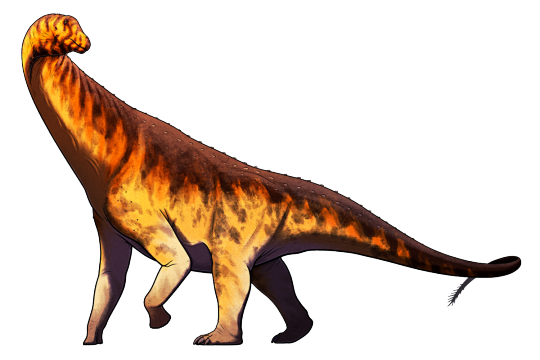
Isisaurus colberti was a sauropod dinosaur that lived in what is now India and Pakistan at the end of the Cretaceous Period, about 70-66 million years ago.
It was part of the titanosaur group of sauropods and had some unusual proportions* compared to its close relatives, with elongated forelimbs and a relatively short chunky neck. Since it's only known from a partial skeleton its full size is unknown – estimates have been made as large as 18m long (~60') but it was probably somewhat smaller, closer to around 11m in length (36').
(*Measurement errors in the original paper resulted in some very weird proportions, but more recent and rigorous reconstructions have made Isisaurus not quite so cursed-looking.)
Like most other titanosaurs it probably lacked the thumb claws seen in other sauropods, and it may also have had some bony osteoderm armor studding its skin.
Coprolites that may represent Isisaurus' poop show evidence of several different fungi that grow on tree leaves in humid tropical and subtropical climates, suggesting that this sauropod was a selective browser somewhat like modern giraffes.
———
NixIllustration.com | Tumblr | Patreon
References:
Jain, Sohan L., and Saswati Bandyopadhyay. "New titanosaurid (Dinosauria: sauropoda) from the Late Cretaceous of central India." Journal of Vertebrate Paleontology 17.1 (1997): 114-136. https://doi.org/10.1080/02724634.1997.10010958
Naish, Darren. "The hands of sauropods: horseshoes, spiky columns, stumps and banana shapes." Tetrapod Zoology, 29 Oct. 2008, https://web.archive.org/web/20121022121526/http://scienceblogs.com/tetrapodzoology/2008/10/29/the-hands-of-sauropods/
Sharma, Neeta, et al. "Fungi in dinosaurian (Isisaurus) coprolites from the Lameta Formation (Maastrichtian) and its reflection on food habit and environment." Micropaleontology 51.1 (2005): 73-82. https://doi.org/10.2113/51.1.73
Wedel, Matt. "How shortweird was Isisaurus?" Sauropod Vertebra Picture of the Week, Aug. 13 2009, https://svpow.com/2009/08/13/how-shortweird-was-isisaurus/
Wikipedia contributors. “Isisaurus” Wikipedia, 27 Dec. 2024, https://en.wikipedia.org/wiki/Isisaurus
Wilson, Jeffrey A., and Paul Upchurch. "A revision of Titanosaurus Lydekker (Dinosauria‐Sauropoda), the first dinosaur genus with a ‘Gondwanan’ distribution." Journal of Systematic Palaeontology 1.3 (2003): 125-160. https://doi.org/10.1017/S1477201903001044
#science illustration#paleontology#paleoart#palaeoblr#isisaurus#titanosaur#sauropod#sauropodomorpha#saurischian#dinosaur#art
306 notes
·
View notes
Text
The megalodon has long been imagined as an enormous great white shark, but new research suggests that perception is all wrong. The study finds the prehistoric hunter had a much longer body—closer in shape to a lemon shark or even a large whale. The study team, which included researchers from the University of California, Riverside and across the globe, used a novel approach to estimate the shark's total body length, moving beyond traditional methods that rely primarily on tooth size. By examining megalodon's vertebral column and comparing it to over 100 species of living and extinct sharks, they determined a more accurate proportion for the head, body, and tail. The findings, published in the journal Palaeontologia Electronica, suggest the prehistoric predator may have reached about 80 feet, or about two school buses in length. It also likely weighed an estimated 94 tons, comparable to a large blue whale, but with a body designed for energy-efficient cruising rather than continuous high-speed pursuit.
Continue Reading.
146 notes
·
View notes
Text
Namib Sand Geckos: these nocturnal geckos have biofluorescent markings that emit a bright, neon-green glow when exposed to the moonlight

This species (Pachydactylus rangei) is found only in the Namib Desert, which stretches across Namibia, Angola, and South Africa; the geckos typically inhabit the arid, coastal region known as the Skeleton Coast.
In order to escape from the blistering heat of the desert, they use their webbed feet to burrow down into the sand during the day, and then emerge only at night, when the temperature has finally dropped. The webbing on their feet also enables them to run more easily across the dunes.
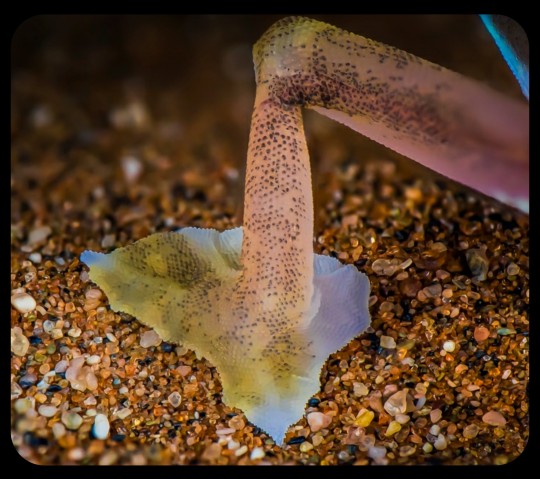
Namib sand geckos are covered in translucent scales, but they also have a strangely colorful appearance, as the colors/shades of their circulatory system, spinal column, internal organs, and optical membranes remain partially visible through the skin, producing various shades of pink, dark blue, purple, magenta, orange, and yellow.
They also have several distinctive markings running along their lower flank and encircling their eyes; these markings are known to fluoresce when exposed to UV light (including moonlight), emitting a bright, neon-green glow.

Some researchers have theorized that the biofluorescent markings may act as a signal to other geckos, allowing them to locate one another in the vast, desolate expanse of the desert, as this paper explains:
The fluorescent areas of P. rangei are concentrated around the eyes and along the lower flanks. This positioning is practically invisible to predators with a higher perspective (e.g. birds and jackals), but highly conspicuous from a gecko’s perspective. As P. rangei is sociable but generally solitary, and occurs at low population densities, such a signal might serve to locate conspecifics over greater distances ...
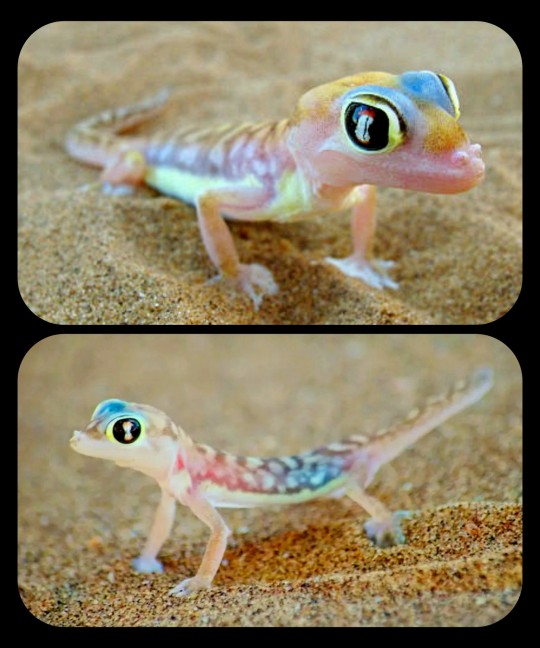
Encounters in P. rangei might serve purposes beyond mating opportunities: as the Namib desert has extremely low precipitation, fog is a key water source for its flora and fauna. Fog condenses on the bodies of the geckos, and they lick it from their faces. In husbandry, we have observed individuals licking water from conspecifics, taking advantage of a much greater available surface area.
Additionally, after short periods of isolation, the geckos run to meet each other. The combination of vital hydration with socialisation might reinforce signals that enable such meetings, and the cost of visibility to predators with higher vantage points, might constrain the signals to regions best visible from eye-level and below.
The Namib sand gecko is the only terrestrial vertebrate that is known to use an iridophore-based form of biofluorescence (you can find a more detailed explanation of that mechanism in the article mentioned above). The fluorescent dermal markings are also unique to this species.
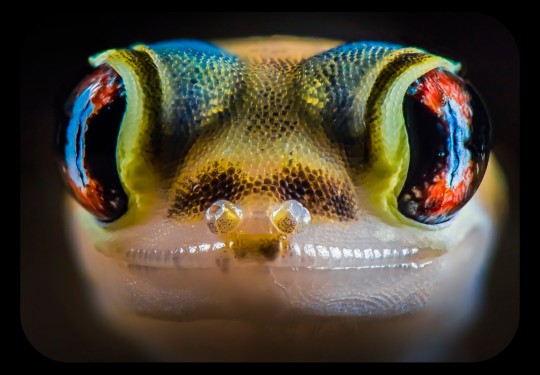
Sources & More Info:
Scientific Reports: Neon-green fluorescence in the desert gecko Pachydactylus rangei caused by iridophores
Animal Diversity Web: Pachydactylus rangei
Dr. Mark D. Scherz's Blog: A Neon-Green Glowing Gecko!
Australian Geographic: Skeleton Coast - Namibia's strange desert dwellers
#herpetology#reptiles#gecko#Pachydactylus rangei#namib sand gecko#palmatogecko#namib desert#namibia#biofluorescence#animals that glow#lizards#cute animals#biology#nature#africa#squamata#web-footed gecko#cool animals#geckos#South Africa#Angola#Skeleton Coast#wildlife#not an arthropod#but still pretty cool
893 notes
·
View notes
Text
Dirty Mirror
Chapter Two - Holding Tight
Word Count - 2363
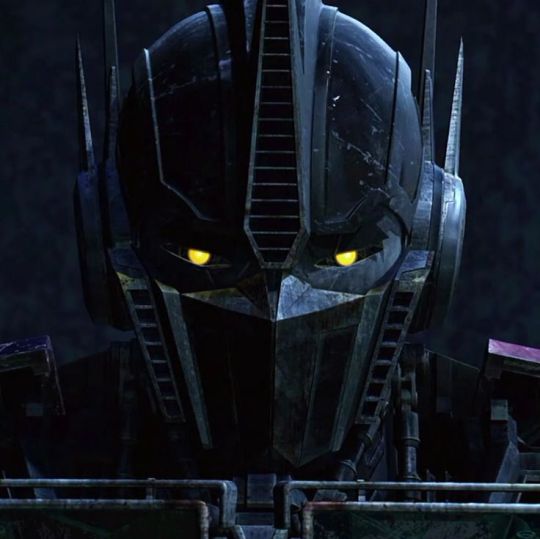
-image not mine-
Chapter One - Lost and Found
Chapter Three - Shot of Clarity
Optimus sat in the hospital room, foot bouncing nervously as he waited for news on your condition from June and the doctor.
Ratchet was pacing the room before him, practically pulling his synthetic hair out.
June had brought you here at sunset. It was now morning. Had you been in surgery this whole time? Were you still alive?
No, he couldn’t think like that.
You were alive, because you were strong. You needed to be strong, for him. He needed you to be alive.
Another earthly hour passed before the Nurse finally emerged from within the hospital to update the bots in the waiting room. June made her way to the men, both standing and taking long strides to meet her in the center of the room.
“Well?” Ratchet asked.
“She’s… stable.” June took a moment to collect herself, tears gathering in her eyes. “The damage she sustained is server. Three broken ribs, bruised lungs, shattered collar bone and fractures in multiple parts on her arms and legs. Almost as if she was crushed by a giant hand.”
The nurse looked at Optimus with an underlying rage for a moment before continuing.
“She’s got a gash on her forehead but a few stitches handled that. The biggest concern is the large fracture at the base of her skull. It is close to her vertebral column. It’s honestly a miracle she isn’t permanently paralyzed.” The nurse wiped the tears from her cheeks, taking a deep breath. “I don’t even understand how she managed to get off that table, let alone move.”
The nurse looked back at the Prime and this time didn’t bother to cover the accusation in her glare. “Why was she scared of you?” June asked, crossing her arms and looking at the Prime expectantly.
Optimus ducked his head. That was the same question that had been on his processor since he left base.
“I do not know.” he managed out softly, spark heavy.
“Can we see her?” Ratchet asked, interrupting the tension and guilt.
“She’s sleeping now. The anesthetic from the surgery is still in her system and the doctors are thinking of inducing a medical coma to help her heal. I think it would be best if you both left.”
Optimus closed his eyes. He’d failed, as a guardian and an Autobot, and now the person he cared most about was suffering. And he couldn’t even be there to help you.
“I’ll send updates to Jack and he can pass them along.” The nurse continued.
Then, with a final hateful glance at the Prime, she turned and headed back into the hospital.
Optimus was vaguely aware of Ratchet leading him back toward his alt mode and assumed he drove back to base because the next thing he remembered was sitting on his berth, feeling cold. Finally in the confines of his berthroom, away from prying eyes, he let his guard drop and freely expressed all the emotions he’d tried to keep locked away.
-------
For the next nine days, the base was silent. No chattering kids or music being played from phones and tv blasting the latest show you kids had become obsessed with.
Ratchet tried to distract himself with work, focusing on trying to track down M.E.C.H and make them answer for the pain they had caused the team.
The rest continued with daily patrols and scouting missions, but those no longer felt important.
The remaining children didn’t talk. They just sat on the catwalk, trying to make it seem like they were doing something. Raf spent a lot of time on his computer, also hoping to find the militia group.
Optimus… changed. He wouldn’t leave his berth, not even for Energon. He just stayed hidden in that dark room, frozen.
He’d seen you go through a few of these before. You’d called them ‘depressive episodes’ and while he’d had a few himself, he never understood how yours went on for so long. Yes, he had supported you, but he never understood when you said that it felt like it would never end.
Now he understood. He understood how it felt like to have everything and nothing flowing through his processor faster than he could comprehend, yet having no will to try make sense of the chaotic noise. And for the first time since he met you, he really understood what it meant to see no hope.
How it felt to feel no hunger, no desire to move, tired but not able to rest. He felt nothing but pain, and fear and empty.
The worst part of it all, of all the quiet, was that only one thought seemed prominent in everyone’s minds: Why was the one you had always felt the safest around now the object of your fear?
-------
On the morning of the tenth day of your medical coma, June Darby phoned the base.
Over the course of the past week and a bit, Jack had been the liaison of your condition but he was at school today.
Was the news that urgent that she needed to tell them immediately? The old medic prepared himself for the worst as he opened the comm. “Nurse Darby?”
“She’s awake.”
And then, the called ended.
The only time Ratchet had ever moved so fast on Earth was when he has using the synthetic Energon. Bolting down the halls, he didn’t even bother to knock before slamming Optimus’ door open.
The Prime was sat at the edge of his bed, looking down at his servos with an unreadable expression as silent tears leaked from his optics.
Optimus lifted his helm, and Ratchet’s presence was all the words he needed. Hot on Ratchet’s trail, the older bots transformed and raced out of the base toward Jasper.
June met them at the doors to the hospital, a weak smile on her tired face.
��Tell us everything.” Ratchet requested, eager to get inside and be with you.
“She woke up about an hour ago. She’s obviously in a lot of pain but we’ve given her some morphine to combat that.” The nurse’s face then fell. “She’s still really scared, and won’t talk to anyone about what happened.”
That was not what they were hoping to hear. But you were awake, and that in of itself was something to be grateful for.
“Can we see her?” Optimus asked softly, voice so weak he surprised himself.
The nurse grimaced. “Right now she needs a calm environment so she can heal. Seeing you might trigger her again.”
Optimus’ spark clenched and he dropped his head.
“But Optimus can stand outside while I talk.” Ratchet spoke, starting to make his way into the hospital.
June just sighed in reply, following the bot inside while Optimus trailed behind.
“She’ll need to stay here for a few more days. And once she can leave, she won’t be able to do much alone.”
“Yes well, once she’s back at base there will be plenty of people to help her.”
June stopped outside a room and turned to the mechs. “Are you sure she’ll want to go back?”
Both bots dropped their gazes. The thought had crossed their minds that you might never want to have contact with the team again after what happened to you. They prayed you would come home.
June knocked on the door softly and opened it. The sound of steady beeps that kept track of your heartbeat soothed Optimus’ racing spark just a fraction.
“I’ve got a visitor for you.” June explained, gesturing for Ratchet to follow her inside.
As soon as he came into your view, the beeps picked up speed and Optimus heard the rustle of your sheets. “No, please. He can’t be here.” you tried to scramble back, having no regard for the pain.
It took all of Optimus’ willpower not to charge into your room.
You were so scared, and it broke his spark that he couldn’t comfort you, because for some reason he seemed to be the cause of your pain.
“Optimus isn’t here.” Ratchet lied.
That stopped your movements but the steady rhythm was still off beat.
“I wanted to come see how you were doing.” Ratchet explained in a calm voice, and Optimus heard his friend sit on the chair no doubt placed at the side of your bed.
“Fine.” you mumbled, offering no more.
It was silent for a long while, and Optimus had to clench his fists and bite the inside of his cheek as a way to fight the urge to burst into the room.
“You wanna know what happened.” Your voice was rough, yet breathy at the same time.
Optimus recognized it immediately, this was your ‘holding back tears’ voice.
“Only if you are ready.” June answered.
It was silent a moment more before you took a deep breath and began. “I was in the hanger, and Silas was there. He asked where the base was. I refused to tell him and then he left. It took a while but then… Optimus came.” Your voice broke. “I tried talking to him but… he wouldn’t listen. He just kept coming closer.” A sob left you and the Prime felt his spark fluctuate. “He-he grabbed me and began squeezing, hard. I begged him to stop but he wouldn’t. Then, he threw me at the wall.” You sniffed then, a few unsteady breaths leaving you as you tried to hold yourself together.
“And you’re certain it was Optimus?” Ratchet asked, as confused as the bot in question was.
Optimus had been in the base, anxiously waiting for any information regarding where you were. He had an entire base full of witnesses. So how had ‘he’ attacked you?
Oh Primus.
Just thinking of hurting you made his frame shudder. But then, the fury settled in.
Someone, no, humans who looked like him had attacked you, taking away the sense of comfort and safety he had always given you and twisted it into fear. The energon boiled in his frame as he thought of all the ways he could make those humans pay.
“He looked kinda dirty. And his optics were yellow. But it was him. His frame, his servo, his voice.”
Your words faded away as quiet sobs overtook your body. But that little bit of information was all they needed to understand. Silas had used Nemesis Prime to attack you.
You’d never actually seen the human remake of Optimus so you wouldn’t have entirely know what was happening at that moment when fear filled your body. That didn’t mean your guardian would be able to forget those terrified eyes that stared back at him as you tried desperately to get away from your enemy.
“I don’t think I’ll ever be able to look at Optimus again.”
-------
After your… spark-wrenching statement Optimus had gone to the waiting room, trying to drown the world out. He knew Ratchet would be explaining to you about Nemesis, but that wouldn’t change the fact that it was his faceplates you saw when the bot was killing you.
While Optimus waited, he thought back to all the memories he had of you and him. Times when you would lie beside him on a hill somewhere and stargaze, or when you played songs from your phone during outings. His favorite memories were by far when you would teach him of Earth and its people.
It was at those times he didn’t need to be a Prime, because you only saw him as Optimus. He could openly express his emotions and unload the weight he carried. You’d listen without hesitation, keeping your focus solely on him. Those moments would be the ones he missed the most, getting to be himself. But if only being the leader was what you needed, then that is who he’d be.
Ratchet came staggering into the waiting room a long while later, looking lost. He sat down heavily beside the Prime. Neither spoke, not for a long time.
“She’s knows of Nemesis.” Ratchet broke the silence after the weight of it became unbearable. “She understands now that it wasn’t you.”
“I still won’t be going to her.” Optimus voiced his decision.
Ratchet turned to his leader in surprise, but kept his mouth shut. He knew there was no way to convince Optimus otherwise.
“She’s resting now if you want to see her.” The medic said softly, standing. “I’m heading back to base to let the others know of her condition.”
The Prime nodded, watching his friend walk out the hospital and toward his alt mode. Once Ratchet’s ambulance was out of sight, he stood and began making his way to your room.
Optimus opened the door as quietly as possible and slipped in, gasping at what he saw.
It would be quicker to name the body parts unbandaged than those covered in the white cloth. A small tube was connected to your nose, no doubt giving you additional oxygen. The beeping on the machines was once again steady and your breathing was how it usually sounded when you slept. An IV was connected to your arm, giving you a clear liquid.
What Optimus wasn’t prepared for however, was how weak the whiteness of the room made you look. Even with your head turned away from him, he could see how sunken your cheeks were and the dark circles under your eyes, despite the fact that you had been sleeping for over a week.
Looking down at you now, for the first time ever, he saw you as fragile. He didn’t see the strong being who he himself looked up to, but saw the young girl he’d allowed to be hurt because of his inability to protect those he cared for. He didn’t see the human who carried burdens as if they were feathers and smiled in face of danger.
What you had said was for the best. Not being around Optimus would keep you safe. And no matter how much it hurt him, he needed to let you go.
Reaching out a shaking hand, he made a reach to take your own smaller one but stopped. Retracting his hand, he turned and moved back toward the door.
“Goodbye, Little One.”
Tags: @ameryhn
#tfp optimus x reader#tfp optimus prime#tfp optimus#optimus x reader#optimus prime#tfp#transformers prime#transformers x reader#tfp x reader#tfp ratchet#tfp arcee#tfp bulkhead#tfp bumblebee#tfp jack#tfp miko#tfp raf#tfp june darby
105 notes
·
View notes
Text
Marine biology nerd reacts to Wuthering Waves fishing minigame! Part 1
Hi, I have a BA in biology with an unofficial specialization in marine bio (my college didn't offer anything more specific) so I love everything that has to do with sea critters, and since my enthusiasm about salps got positive reception, I would love to yap about some fun facts relevant to the obtainable fish present in the new fishing minigame in Wuthering Waves 🐟🌊
We're going to start with the...
Fried Egg Jellyfish

The fried egg jellyfish in Wuthering Waves looks like a pretty out-of-pocket design, but fried egg jellies are, in fact, real animals!
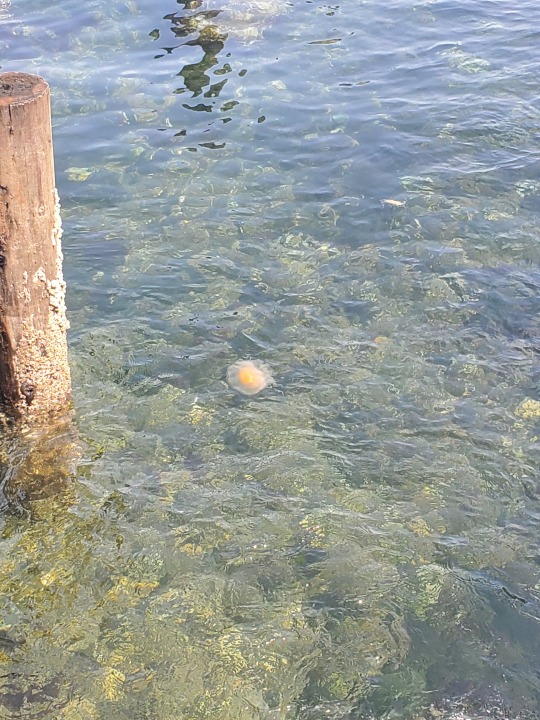
Sharing this photo again of one I took near a body of water in my region -- they do legitimately look like fried eggs. 😂 They belong to the genus Phacellophora and are found in most of the world's oceans. (Not to be confused with Cotylorhiza tuberculata, which is also called the "fried egg jellyfish" but is a different species.)
I'm not sure if it varies by region, but where I live, the best time to see them is between mid-July and mid-August, when they appear in droves -- so I see them often enough that I was positively ticked to see them featured in Wuthering Waves essentially unaltered. The caveat would be the note about them purportedly tasting like fried eggs; while some species of jellyfish are indeed edible when prepared properly, I'm not sure about this one specifically, so I can't say I endorse trying -- and even if they are, they probably don't taste like eggs, as jellyfish supposedly bears little to no flavor.
Yarn Eel

I'm going to guess this one is a play on the real animal called the ribbon eel, which is indeed quite colorful, but not necessarily found in large knots. Apparently, while they don't do so well in captivity, they can live for up to twenty years in the wild! (So, depending on who all is reading this... there might be ribbon eels out there that are your age or older. 👀)
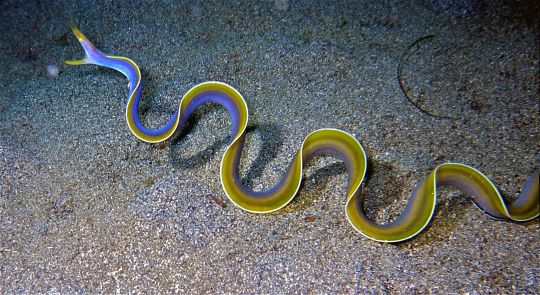
(Image source)
Sob Blob

Many of us might be familiar with the infamous, meme-worthy photo of the "blobfish" on which this critter is quite clearly based. However, did you know that said photograph does not accurately portray what blobfish usually look like?
Blobfish live on the seabed at depths of up to over nine thousand (!!!) feet; to maintain their integrity against the immense pressure at that depth, the blobfish's soft tissues are full of water and fat. So if a blobfish were to get caught in a net and very abruptly moved to sea level, where the pressure is much lower, its "water-logged" tissues effectively explode, giving it the unnatural "blob" appearance featured in the infamous photo.
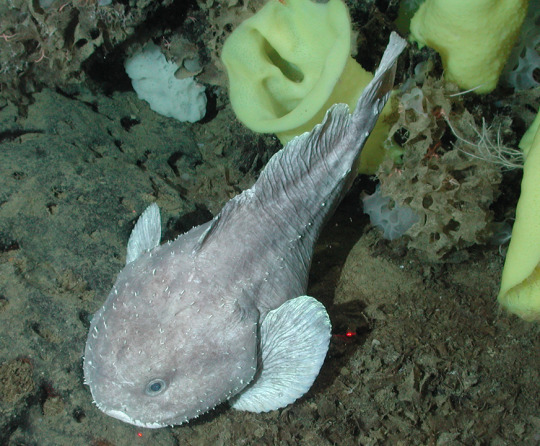
(Image from NOAA, in the public domain)
This is a real blob sculpin shown in its natural habitat -- and in a much more fish-shaped state! Moreover, unlike the in-game Sob Blob, blobfish don't have a lot of natural predators and can get away with a rather sedentary lifestyle in which they remain largely stationary unless it's absolutely necessary for them to move. Moisturized, unbothered, flourishing.
And, saving probably my favorite featured critter of the bunch for last:
Salp

Salps are much less well-known critters than any of the ones I've described so far, I think! Aside from in Wuthering Waves, I've only ever heard mention of them in the 2007 video game Endless Ocean (of which I was also a huge fan back when I had a Wii). I would say they're not prominent in popular culture by any stretch of the imagination, as far as I'm aware.
Salps are tunicates, a type of marine invertebrate that is nevertheless part of the phylum Chordata that includes all vertebrates, as tunicates possess notochords (the embryonic precursor to the vertebral column), as well as other chordate features, in their larval stage. In this case, the in-game description is at least partially accurate, as salps are a key component of the marine ecosystem and are thought to be a food source for a great many other animals, including fish and seabirds -- though it's difficult to tell exactly which ones, since they're gelatinous and don't leave behind much evidence of being eaten in their predators' digestive tracts. They're also purportedly one of the fastest-growing multicellular animals in the world.
Their life cycle involves an alternation between solitary and "chain" phases depending on the generation. While the salps' in-game entry describes them as sometimes "too small to bother with," IRL the biggest salp colonies can literally grow to lengths of one hundred feet!
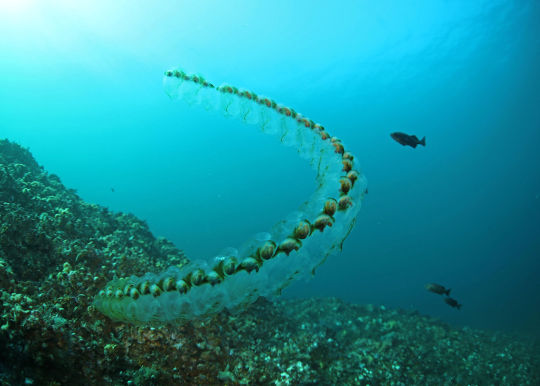
(Image source)
That's about all I have time for today! I've got more critters I can talk about, so be sure to let me know if you're interested in a part two 😉
Part 1 (you are here) -- Part 2 -- Part 3
79 notes
·
View notes